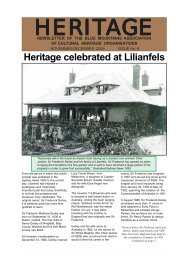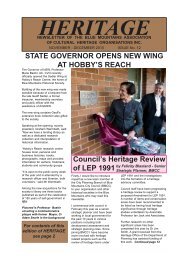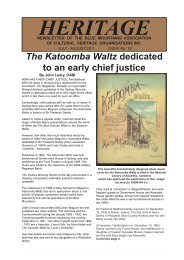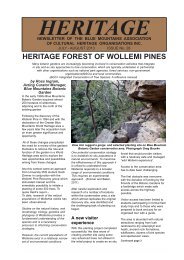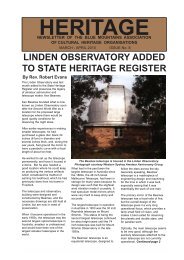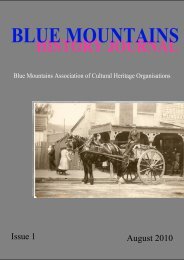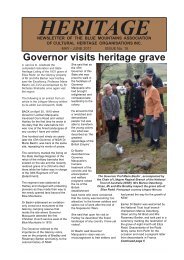Blue Mountains History Journal Issue 2
Blue Mountains History Journal Issue 2
Blue Mountains History Journal Issue 2
Create successful ePaper yourself
Turn your PDF publications into a flip-book with our unique Google optimized e-Paper software.
<strong>Blue</strong> <strong>Mountains</strong> <strong>History</strong> <strong>Journal</strong> 2; 2011<br />
sketchbook records a trip taken during the early spring at the time that her husband would have been<br />
preparing the final report, which he issued in September. With her husband’s impending resignation<br />
and the family’s imminent return to England in mind, it offered a final opportunity for Mary to visit<br />
the region. With sketchbook in hand she appears to have travelled in a mixed party, possibly made up<br />
of other officers of her husband’s department and their wives.<br />
The uninhibited honesty that characterizes several of her sketches is apparent on the title page (Figure<br />
4).<br />
The dramatic images of broken wheel<br />
and bullock skeleton make an<br />
immediate visual comment on the<br />
condition of the Western Road, the<br />
difficulties of travel, and the heavy toll<br />
the road took on vehicles and animals.<br />
Though Mary must have sympathized<br />
with her husband over some of the<br />
stinging attacks he suffered from<br />
politicians and the press, she was not<br />
going to falsely exaggerate his<br />
achievements as Commissioner of<br />
Roads!<br />
Figure 4. Our Trip to the <strong>Blue</strong> <strong>Mountains</strong> 1860, Title Page<br />
(Martindale 1860b; Mitchell Library, SLNSW).<br />
In her sketchbook, Mary Martindale<br />
drew two sketches of coaches, one of<br />
an old-style, pre-Cobb & Co. ‘Royal<br />
Mail’ (Figure 5) that she probably encountered changing horses at an inn along the way, and one of a<br />
coach (presumably her own) emerging from a bog, with the horse’s backside in the air as it begins to<br />
negotiate another deep pothole in the road (Figure 6). As well as honesty, there is also in this latter<br />
sketch a touch of humour at her husband’s expense, a further insight into the artist’s personality and<br />
perhaps the strength of her domestic relationship.<br />
Figure 5. Royal Mail Coach(Martindale<br />
1860b; Mitchell Library SLNSW).<br />
Figure 6. Negotiating the Western Road<br />
(Martindale 1860b; Mitchell Library,SLNSW)<br />
Landscape scenes, buildings, and people she travelled with or met along the way feature prominently<br />
among her sketches. Some sketches have penciled notes on the reverse but these are often inconclusive<br />
and are probably later attempts at identification, perhaps by the artist herself in old age or by other<br />
family members.<br />
Two sketches ‘book-end’ the journey, depicting her probable starting and finishing points. The first,<br />
an un-titled town scene with buildings, pedestrians and a horse-drawn cart is almost certainly of Church<br />
Street, Parramatta, drawn from its intersection with George Street, looking north (Figure 7).<br />
5 Back to Contents




